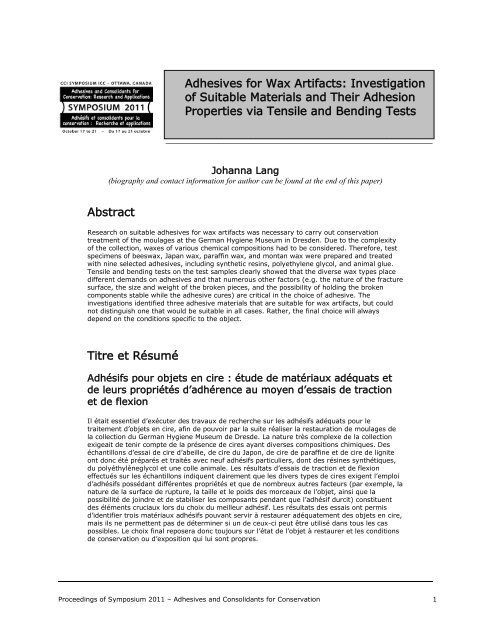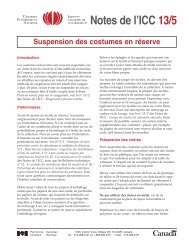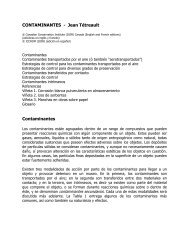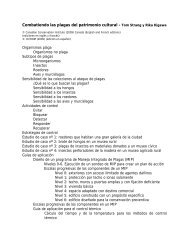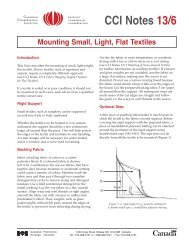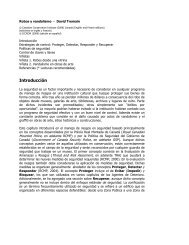Adhesives for Wax Artifacts - Institut canadien de conservation
Adhesives for Wax Artifacts - Institut canadien de conservation
Adhesives for Wax Artifacts - Institut canadien de conservation
Create successful ePaper yourself
Turn your PDF publications into a flip-book with our unique Google optimized e-Paper software.
_______________________________________________________<br />
Johanna Lang<br />
(biography and contact in<strong>for</strong>mation <strong>for</strong> author can be found at the end of this paper)<br />
Abstract<br />
Research on suitable adhesives <strong>for</strong> wax artifacts was necessary to carry out <strong>conservation</strong><br />
treatment of the moulages at the German Hygiene Museum in Dres<strong>de</strong>n. Due to the complexity<br />
of the collection, waxes of various chemical compositions had to be consi<strong>de</strong>red. There<strong>for</strong>e, test<br />
specimens of beeswax, Japan wax, paraffin wax, and montan wax were prepared and treated<br />
with nine selected adhesives, including synthetic resins, polyethylene glycol, and animal glue.<br />
Tensile and bending tests on the test samples clearly showed that the diverse wax types place<br />
different <strong>de</strong>mands on adhesives and that numerous other factors (e.g. the nature of the fracture<br />
surface, the size and weight of the broken pieces, and the possibility of holding the broken<br />
components stable while the adhesive cures) are critical in the choice of adhesive. The<br />
investigations i<strong>de</strong>ntified three adhesive materials that are suitable <strong>for</strong> wax artifacts, but could<br />
not distinguish one that would be suitable in all cases. Rather, the final choice will always<br />
<strong>de</strong>pend on the conditions specific to the object.<br />
Titre et Résumé<br />
<strong>Adhesives</strong> <strong>for</strong> <strong>Wax</strong> <strong>Artifacts</strong>: Investigation<br />
of Suitable Materials and Their Adhesion<br />
Properties via Tensile and Bending Tests<br />
Adhésifs pour objets en cire : étu<strong>de</strong> <strong>de</strong> matériaux adéquats et<br />
<strong>de</strong> leurs propriétés d’adhérence au moyen d’essais <strong>de</strong> traction<br />
et <strong>de</strong> flexion<br />
Il était essentiel d’exécuter <strong>de</strong>s travaux <strong>de</strong> recherche sur les adhésifs adéquats pour le<br />
traitement d’objets en cire, afin <strong>de</strong> pouvoir par la suite réaliser la restauration <strong>de</strong> moulages <strong>de</strong><br />
la collection du German Hygiene Museum <strong>de</strong> Dres<strong>de</strong>. La nature très complexe <strong>de</strong> la collection<br />
exigeait <strong>de</strong> tenir compte <strong>de</strong> la présence <strong>de</strong> cires ayant diverses compositions chimiques. Des<br />
échantillons d’essai <strong>de</strong> cire d’abeille, <strong>de</strong> cire du Japon, <strong>de</strong> cire <strong>de</strong> paraffine et <strong>de</strong> cire <strong>de</strong> lignite<br />
ont donc été préparés et traités avec neuf adhésifs particuliers, dont <strong>de</strong>s résines synthétiques,<br />
du polyéthylèneglycol et une colle animale. Les résultats d’essais <strong>de</strong> traction et <strong>de</strong> flexion<br />
effectués sur les échantillons indiquent clairement que les divers types <strong>de</strong> cires exigent l’emploi<br />
d’adhésifs possédant différentes propriétés et que <strong>de</strong> nombreux autres facteurs (par exemple, la<br />
nature <strong>de</strong> la surface <strong>de</strong> rupture, la taille et le poids <strong>de</strong>s morceaux <strong>de</strong> l’objet, ainsi que la<br />
possibilité <strong>de</strong> joindre et <strong>de</strong> stabiliser les composants pendant que l’adhésif durcit) constituent<br />
<strong>de</strong>s éléments cruciaux lors du choix du meilleur adhésif. Les résultats <strong>de</strong>s essais ont permis<br />
d’i<strong>de</strong>ntifier trois matériaux adhésifs pouvant servir à restaurer adéquatement <strong>de</strong>s objets en cire,<br />
mais ils ne permettent pas <strong>de</strong> déterminer si un <strong>de</strong> ceux-ci peut être utilisé dans tous les cas<br />
possibles. Le choix final reposera donc toujours sur l’état <strong>de</strong> l’objet à restaurer et les conditions<br />
<strong>de</strong> <strong>conservation</strong> ou d’exposition qui lui sont propres.<br />
Proceedings of Symposium 2011 – <strong>Adhesives</strong> and Consolidants <strong>for</strong> Conservation 1


